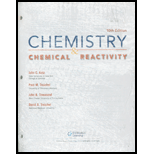
(a)
Interpretation: The enthalpy of combustion of ethanol and isooctane, the fuel which release more
Concept introduction:
Enthalpy of combustion: At standard conditions when one mole of substance is burnt completely in presence of oxygen, the enthalpy change involved is called enthalpy of combustion.
(a)
Answer to Problem 47GQ
Isooctane release more energy than ethanol.
Explanation of Solution
Given the combustion of ethanol and isooctane:
Enthalpy of combustion can be calculated by the equation:
Enthalpy of combustion can be calculated by the equation:
Isooctane releases more energy per kilogram.
(b)
Interpretation: compare the enthalpy of combustion of ethanol and isooctane and the fuel which release more
Concept introduction:
Enthalpy of combustion: At standard conditions when one mole of substance is burnt completely in presence of oxygen, the enthalpy change involved is called enthalpy of combustion.
(b)
Answer to Problem 47GQ
Ethanol produces less
Explanation of Solution
One mole of ethanol produces two moles of
The number of moles
One mole of isooctane produces eight moles of
The number of moles
Isooctane release more amount of
(c)
Interpretation: The better fuel in terms of energy production and greenhouse gases should be determined.
Concept introduction:
Enthalpy of combustion: At standard conditions when one mole of substance is burnt completely in presence of oxygen, the enthalpy change involved is called enthalpy of combustion.
(c)
Answer to Problem 47GQ
Isooctane releases more energy, but it releases more
Explanation of Solution
In-order to say whether ethanol or isooctane is a better fuel, we have to compare its energy release.
Comparing ethanol and isooctane, isooctane releases more energy.
But the problem is that when we compare the
On the basis of energy release isooctane can be considered as a better fuel, but when the release of
Want to see more full solutions like this?
Chapter 20 Solutions
CHEMISTRY+CHEM...(LL)-W/ACCESS >CUSTOM<
- Can I please get help with this?arrow_forwardUse the Henderson-Hasselbalch equation to calculate pH of a buffer containing 0.050M benzoic acidand 0.150M sodium benzoate. The Ka of benzoic acid is 6.5 x 10-5arrow_forwardA. Draw the structure of each of the following alcohols. Then draw and name the product you would expect to produce by the oxidation of each. a. 4-Methyl-2-heptanol b. 3,4-Dimethyl-1-pentanol c. 4-Ethyl-2-heptanol d. 5,7-Dichloro-3-heptanolarrow_forward
- What is the pH of a 1.0 L buffer made with 0.300 mol of HF (Ka = 6.8 × 10⁻⁴) and 0.200 mol of NaF to which 0.160 mol of NaOH were added?arrow_forwardCan I please get help with this.arrow_forwardDetermine if the following salt is neutral, acidic or basic. If acidic or basic, write the appropriate equilibrium equation for the acid or base that exists when the salt is dissolved in aqueous solution. If neutral, simply write only NR. Be sure to include the proper phases for all species within the reaction. N₂H₅ClO₄arrow_forward
 Chemistry: Principles and PracticeChemistryISBN:9780534420123Author:Daniel L. Reger, Scott R. Goode, David W. Ball, Edward MercerPublisher:Cengage Learning
Chemistry: Principles and PracticeChemistryISBN:9780534420123Author:Daniel L. Reger, Scott R. Goode, David W. Ball, Edward MercerPublisher:Cengage Learning Chemistry by OpenStax (2015-05-04)ChemistryISBN:9781938168390Author:Klaus Theopold, Richard H Langley, Paul Flowers, William R. Robinson, Mark BlaserPublisher:OpenStax
Chemistry by OpenStax (2015-05-04)ChemistryISBN:9781938168390Author:Klaus Theopold, Richard H Langley, Paul Flowers, William R. Robinson, Mark BlaserPublisher:OpenStax Chemistry: The Molecular ScienceChemistryISBN:9781285199047Author:John W. Moore, Conrad L. StanitskiPublisher:Cengage Learning
Chemistry: The Molecular ScienceChemistryISBN:9781285199047Author:John W. Moore, Conrad L. StanitskiPublisher:Cengage Learning ChemistryChemistryISBN:9781305957404Author:Steven S. Zumdahl, Susan A. Zumdahl, Donald J. DeCostePublisher:Cengage Learning
ChemistryChemistryISBN:9781305957404Author:Steven S. Zumdahl, Susan A. Zumdahl, Donald J. DeCostePublisher:Cengage Learning Chemistry: An Atoms First ApproachChemistryISBN:9781305079243Author:Steven S. Zumdahl, Susan A. ZumdahlPublisher:Cengage Learning
Chemistry: An Atoms First ApproachChemistryISBN:9781305079243Author:Steven S. Zumdahl, Susan A. ZumdahlPublisher:Cengage Learning





